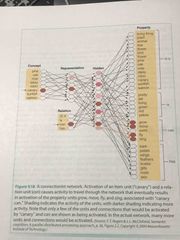![]()
![]()
![]()
Use LEFT and RIGHT arrow keys to navigate between flashcards;
Use UP and DOWN arrow keys to flip the card;
H to show hint;
A reads text to speech;
24 Cards in this Set
- Front
- Back
|
Conceptual knowledge |
Knowledge that enables us to recognise objects and events and to make inferences about their properties |
|
|
Concepts |
Mental representation/meaning of class, objects, events ect. |
|
|
Catagory |
The way we organise concepts |
|
|
Categorising by definition |
Good for the majority of things however never a encompasses the full scope of the concept |
|
|
Categorising by prototype |
Comparing an object to the prototype that represents the typical member of the category Family resemblance- things in a particular category resemble one another in a number of ways -> allows for variation Strong relationship between prototypicality and family resemblance |
|
|
High/low typicality |
Closely resembles the category prototype Does not closely resemble the category prototype |
|
|
Typicality effect |
Ability to judge highly prototypical objects more rapidly than low prototypical object |
|
|
Categorising by exemplar |
Compares objects similarity like the prototype approach however while the prototype is a single example to which the object is campers against the exemplar approach is the object being compared to many examples within the category Takes into account larger variations eg. Flightless birds such as penguins, represented as exemplars |
|
|
Prototype vs exemplar |
Prototype is essential in early learning, once our knowledge increase exemplar strengthens Prototype better for larger categories Exemplar better for smaller categories |
|
|
Three levels of categories |
Superordinate/global level - furniture - loss of information Basic level - table Subordinate/specific level - kitchen table - gain little information |
|
|
Categorising; semantic network |
Items higher in the model are faster to retrieve than lower items eg. Bird vs canary |
|
|
Connectionism |

Approach to creating computer models for representing cognitive processes Units/circle are inspired by neurons Shows input/output and hidden units joining them |
|
|
Connection weight |
How signal sent from one unit to another either increases or decreases |
|
|
Sensory-function hypothesis |
Our ability to differentiate living things and artefacts depends on a semantic memory system that distinguishes sensory attributes and a system that distinguishes function Definition may be too simplified |
|
|
Semantic category approach |
Specific neural circuits in the brain for specific j |
|
|
Multiple-factor approach |
Instead of focusing on only one property or feature to distinguish between objects and animals, people use multiple factors to divide concepts within categories |
|
|
Animals are more associated with |
Colour and motion |
|
|
Artefacts are more associated with |
Performance action |
|
|
Mechanical device is associated |
Both motion and performance |
|
|
Crowding |
Animals tend to share many properties in contrast, artefacts share fewer properties Therefor people who have category-specific impairment for living animals may not have the category-specific impairment but rather just find it hard to distinguish between these similar properties |
|
|
Embodied approach |
Our knowledge of concepts is based on reactivation of sensory and motor processes that occur when we interact with the object Using a hammer -> sensory activate in response to the shape, size, colour, motor areas used with a hammer |
|
|
Mirror neurons |
Fires both when an animals acts and observes an action |
|
|
Semantic somatotopy |
Correspondence between words related to specific parts of the body and the location of brain activity |
|
|
The hub and spike model |
Semantic dementia - general loss of knowledge for all concepts -> equally deficient in identifying living things and artefacts Damaged anterior temporal lobe ATL The model suggests ares of the brain that are associated with specific functions are connected to the ATL which serves as a hub that integrates information from these areas ATL damage causes general semantic dementia |

